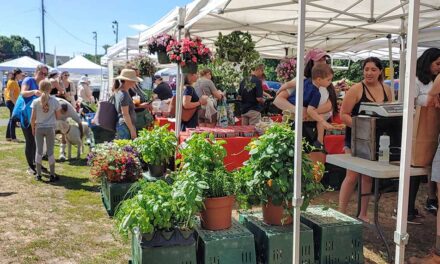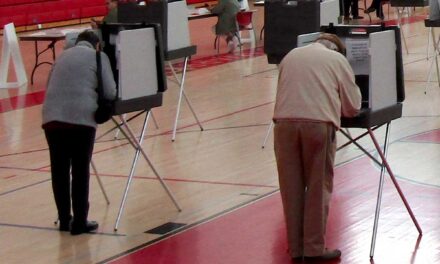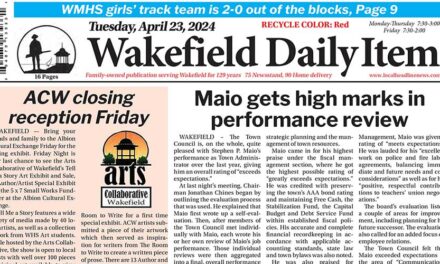Published in the December 10, 2015 edition.
By MARK SARDELLA
Who did she think she was – this outside consultant with her studies and her facts and figures – coming in and telling us that our downtown isn’t the economic Death Valley we’ve been led to believe it is? How dare she suggest that revitalization doesn’t happen overnight and that the citizens we’ve chosen to represent us might actually be on the right track?
Peg Barringer presented the findings of her study of Wakefield’s downtown business district at a meeting last week in the The Savings Bank. About 20 interested people showed up, including elected town officials, town department heads, business owners and private citizens.
Barringer, director of economic consulting for FinePoint, LLC, has 25 years of experience in downtown and business district revitalization. She has conducted economic and financial analysis, market research, training, business planning and other services for government agencies, financial institutions, real estate developers and community based organizations. She teaches Urban Policy and Planning at Tufts University.
But hey, what does she know?
Her conclusions may shock those who have heard tales of a vast economic wasteland extending from the Rockery to the Junction.
There’s plenty of room for economic development and growth in Wakefield’s downtown, of course. But contrary to the dire diagnosis that we hear from some quarters, Barringer found that our downtown isn’t ready for life support just yet.
In fact, Wakefield compares quite favorably to other communities, like Reading for example, that “inclusive” town that we should be emulating. What’s more, it turns out that some of the steps Barringer recommends to help our downtown increase its economic vibrancy were already in place even before she was brought in.
One of the most frequently heard complaints about Wakefield’s downtown is the number of vacant store fronts. To hear some tell it, the downtown area is a ghost town – albeit one with a parking problem.
But in October 2015, Barringer found that only about 7 percent of the commercial square footage and 12 percent of the commercial units were vacant in the downtown area. From that perspective, Wakefield’s downtown is actually in better shape than the national average, according to Barringer.
She also looked at the downtown’s primary and secondary “trade areas,” defined as within a two-mile and three-mile radius of the downtown, respectively. That’s where most of the potential customers live.
Barringer found that Wakefield’s primary trade area is capturing 62 percent of the spending by residents within that trade area. That means that people who live within two miles of downtown are doing 62 percent of their total spending within two miles of the downtown.
“That’s a pretty strong capture rate,” Barringer said. Reading’s capture rate of 75 percent, she noted, is a little bit higher. “But 62 percent is pretty high.”
Could this relatively strong economic performance have something to do with the attractiveness of Wakefield’s downtown? Our local critics like to tell us how shabby our downtown is compared to other communities where the grass is always greener.
But Barringer must have missed the tumbleweeds rolling down Main Street, because her trained eye saw something different.
“Wakefield has a charming town center with many attractive historic buildings, a walkable layout and a lovely common,” she observed in her report. “The new lifestyle centers that are currently being developed (such as MarketStreet) are trying to create the physical layout and potential social environment that Wakefield already has.”
Wait – you mean Lynnfield’s MarketStreet, that economic goldmine, is actually imitating us?
Who dares speak this heresy?!
Barringer pointed to MarketStreet’s emphasis on the “social” as much as the shopping aspect. If people are made to feel comfortable and are given reasons to hang around the downtown, she said, they’ll stay and spend money.
She also suggested leveraging public spaces and activity venues to strengthen economic links to business. Things like the Holiday Stroll, Festival Italia, the Festival by the Lake, the Independence Day events and the Farmers Market come to mind. And then there’s that group working hard to turn the former Light Department offices at 9 Albion St. into a downtown arts and cultural center.
Barringer pointed out that businesses and restaurants with large, open windows (Sabatino’s, Sakura, Farmland, Brothers?) encourage a connection between business and sidewalk traffic, as does outdoor and sidewalk dining. Didn’t Town Meeting pass a bylaw aimed at encouraging sidewalk/outdoor dining in the downtown a few years ago? We’re now seeing more restaurants starting to take advantage of it.
Barringer’s report also recommended “encouraging residential development in and near the downtown.”
Funny she should mention that.
Despite being loudly opposed by the same tiny minority that opposes every revitalization effort, Wakefield citizens at the recent Town meeting overwhelmingly saw the wisdom of encouraging residential development in and around the downtown and passed Article 12 by a vote of 123-41.
If I wasn’t constantly being told otherwise, I’d almost think that our fellow citizens had a pretty good handle on downtown revitalization efforts.
Does that mean we should pat ourselves on the back and rest on our laurels? Nope. But characterize a place as a disaster area often enough and before long perception overtakes reality, creating a self-fulfilling prophesy.
Contrary to the ceaseless hectoring of our local self-appointed prophets of gloom and doom, the recent professional downtown market assessment paints a much more positive, brighter and optimistic picture for our downtown and its future potential.
I don’t know about you, but I’m going with the professional on this one.





